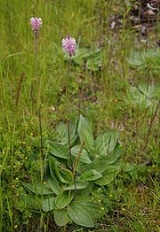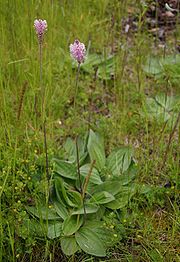
Anemophily
Encyclopedia

Pollination
Pollination is the process by which pollen is transferred in plants, thereby enabling fertilisation and sexual reproduction. Pollen grains transport the male gametes to where the female gamete are contained within the carpel; in gymnosperms the pollen is directly applied to the ovule itself...
whereby pollen
Pollen
Pollen is a fine to coarse powder containing the microgametophytes of seed plants, which produce the male gametes . Pollen grains have a hard coat that protects the sperm cells during the process of their movement from the stamens to the pistil of flowering plants or from the male cone to the...
is distributed by wind
Wind
Wind is the flow of gases on a large scale. On Earth, wind consists of the bulk movement of air. In outer space, solar wind is the movement of gases or charged particles from the sun through space, while planetary wind is the outgassing of light chemical elements from a planet's atmosphere into space...
. Anemophilous plants may be either gymnosperms (non-flowering) or angiosperms (flower-producing).
However, flowering anemophilous species do not develop scented flower
Flower
A flower, sometimes known as a bloom or blossom, is the reproductive structure found in flowering plants . The biological function of a flower is to effect reproduction, usually by providing a mechanism for the union of sperm with eggs...
s, nor do they produce nectar. This distinguishes them from entomophilous
Entomophily
Entomophily is a form of pollination whereby pollen is distributed by insects. Several insect are reported to be responsible for the pollination of many plant species, particularly bees, Lepidoptera , wasps, flies, ants and beetles. Some plant species co-evolved with a particular pollinator, such...
and zoophilous
Zoophily
Zoophily is a form of pollination whereby pollen is transferred by vertebrates, particularly by hummingbirds and other birds, and bats, but also by monkeys, marsupials, lemurs, bears, rabbits, deer, rodents, lizards and other animals...
species (whose pollen is spread by insect
Insect
Insects are a class of living creatures within the arthropods that have a chitinous exoskeleton, a three-part body , three pairs of jointed legs, compound eyes, and two antennae...
s and vertebrate
Vertebrate
Vertebrates are animals that are members of the subphylum Vertebrata . Vertebrates are the largest group of chordates, with currently about 58,000 species described. Vertebrates include the jawless fishes, bony fishes, sharks and rays, amphibians, reptiles, mammals, and birds...
s respectively).
Male and female reproductive organs are generally found in separate flowers, the male flowers having a number of long filaments terminating in exposed stamen
Stamen
The stamen is the pollen producing reproductive organ of a flower...
s, and the female flowers having long, feather
Feather
Feathers are one of the epidermal growths that form the distinctive outer covering, or plumage, on birds and some non-avian theropod dinosaurs. They are considered the most complex integumentary structures found in vertebrates, and indeed a premier example of a complex evolutionary novelty. They...
-like stigmas.
Pollen from anemophilous plants tends to be smaller and lighter in weight than pollen from entomophilous ones, with very low nutritional value to insects. However, insects sometimes gather pollen from staminate anemophilous flowers at times when higher protein
Protein
Proteins are biochemical compounds consisting of one or more polypeptides typically folded into a globular or fibrous form, facilitating a biological function. A polypeptide is a single linear polymer chain of amino acids bonded together by peptide bonds between the carboxyl and amino groups of...
pollens from entomophilous flowers are scarce. Also anemophilous pollens may also be inadvertently captured by bee
Bee
Bees are flying insects closely related to wasps and ants, and are known for their role in pollination and for producing honey and beeswax. Bees are a monophyletic lineage within the superfamily Apoidea, presently classified by the unranked taxon name Anthophila...
s' electrostatic field. This may explain why, though bees are not observed to visit ragweed
Ragweed
Ragweeds are flowering plants in the genus Ambrosia in the sunflower family Asteraceae. Common names include bitterweeds and bloodweeds....
flowers, its pollen is often found
Melissopalynology
Melissopalynology is the study of pollen contained in honey and, in particular, the pollen's source. By studying the pollen in a sample of honey, it is possible to gain evidence of the geographical location and genus of the plants that the honey bees visited, although honey may also contain...
in honey
Honey
Honey is a sweet food made by bees using nectar from flowers. The variety produced by honey bees is the one most commonly referred to and is the type of honey collected by beekeepers and consumed by humans...
made during the ragweed floral bloom. Other flowers that are generally anemophilous are observed to be actively worked by bees, with solitary bees often visiting grass
Poaceae
The Poaceae is a large and nearly ubiquitous family of flowering plants. Members of this family are commonly called grasses, although the term "grass" is also applied to plants that are not in the Poaceae lineage, including the rushes and sedges...
flowers, and the larger honeybees and bumblebee
Bumblebee
A bumble bee is any member of the bee genus Bombus, in the family Apidae. There are over 250 known species, existing primarily in the Northern Hemisphere although they are common in New Zealand and in the Australian state of Tasmania.Bumble bees are social insects that are characterised by black...
s frequently gathering pollen from corn
Maize
Maize known in many English-speaking countries as corn or mielie/mealie, is a grain domesticated by indigenous peoples in Mesoamerica in prehistoric times. The leafy stalk produces ears which contain seeds called kernels. Though technically a grain, maize kernels are used in cooking as a vegetable...
tassels and other grains.
Almost all pollens that are allergen
Allergen
An allergen is any substance that can cause an allergy. In technical terms, an allergen is a non-parasitic antigen capable of stimulating a type-I hypersensitivity reaction in atopic individuals....
s are anemophilous. Ragweed
Ragweed
Ragweeds are flowering plants in the genus Ambrosia in the sunflower family Asteraceae. Common names include bitterweeds and bloodweeds....
, the bane of many hayfever sufferers, is anemophilous. Its pollen has been found at sea hundreds of miles from its source. Spring hayfever often traces to pollens from birch
Birch
Birch is a tree or shrub of the genus Betula , in the family Betulaceae, closely related to the beech/oak family, Fagaceae. The Betula genus contains 30–60 known taxa...
es.
Other common anemophilous plants are grass
Grass
Grasses, or more technically graminoids, are monocotyledonous, usually herbaceous plants with narrow leaves growing from the base. They include the "true grasses", of the Poaceae family, as well as the sedges and the rushes . The true grasses include cereals, bamboo and the grasses of lawns ...
species, conifers, sweet chestnut
Sweet Chestnut
Castanea sativa is a species of the flowering plant family Fagaceae, the tree and its edible seeds are referred to by several common names such Sweet Chestnut or Marron. Originally native to southeastern Europe and Asia Minor, it is now widely dispersed throughout Europe and parts of Asia, such as...
s, and members of the hickory
Hickory
Trees in the genus Carya are commonly known as hickory, derived from the Powhatan language of Virginia. The genus includes 17–19 species of deciduous trees with pinnately compound leaves and big nuts...
family.
in anemophilous flowers, pollens are light and non sticky so that they can be transported by air currents.
They possess well exposed stamen so that the pollens are well exposed to wind currents.
They have large and feathery stigma to easily trap air borne pollen grains

